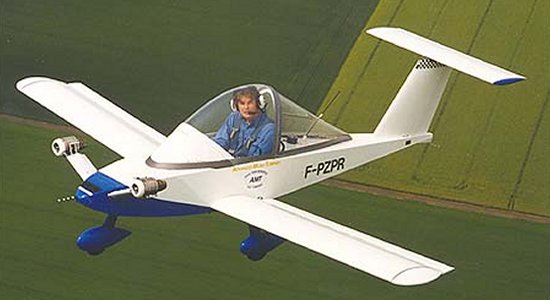|
||||||||||
|
|
||||||||||
|
||||||||||
|
|
||||||||||

The Cri-Cri is a popular homebuilt design developed in France by engineer and pilot Michel Colomban. Colomban became fascinated by small aircraft and hoped to create a tiny and economical plane with good performance and aerobatic capabilities. His goal was a very simple and lightweight construction using no more than a 20-hp engine powering an airframe carrying a 172 lb (78 kg) pilot and 22 lb (10 kg) of fuel. Colomban's initial study in the late 1950s suggested that a single seat aircraft with a maximum takeoff weight of 395 lb (180 kg) and a wing area of 43 ft² (4 m²) was feasible.
Over a decade later, Colomban returned to his pet project but was able to make several improvements due to advances in technology. He incorporated new more efficient low-drag airfoils, composite parts, and thinner sheet metal for the wing skin to reduce weight and wing area to just 33 ft² (3.1 m²). The new aircraft also adopted twin 8-hp Stihl chain-saw engines, like those used aboard ultralights, in place of the planned single 20-hp engine. The change not only made the aircraft lighter but also improved the efficiency of each engine's propeller. Construction of the first example took about 1,500 hours, and several structural load tests were conducted to prove its advanced design elements were safe.

The new aircraft was finally ready by 1973. Colomban dubbed his unique aircraft the Cri-Cri, French for "cricket", after the nickname of his daughter. With an empty weight of just 139 lb (63 kg), the remarkable plane carries a single pilot in a bubble canopy that gives excellent visibility. The tiny Cri-Cri has a wingspan of 16.1 ft (4.9 m) and is a mere 12.83 ft (3.9 m) in length. The prototype, known as the MC10, made its maiden flight on 19 July 1973 and appeared at the National Amateur Constructors Meeting soon thereafter.
While the Cri-Cri's small size and low cost made it attractive, it was the plane's exceptional aerobatic performance that quickly won praise from those who observed its demonstration flights during the 1970s. The diminutive Cri-Cri is capable of a maximum speed up to 125 mph (200 km/h) and a 360°/second roll rate. The amateur homebuilt market rapidly bought up plans and manuals to build their own, but many were frustrated by manufacturing problems as well as difficulties locating and tuning the engines. It took another decade for these issues to be completely resolved, but Colomban eventually began issuing assembly instructions and operating manuals to his growing market.

Estimates vary but up to 150 flyable examples of the Cri-Cri are believed to exist today. About 100 of these are registered in France, another 30 in the US, and the remainder are scattered around the world including Germany and Canada. Plans are reportedly still available from Michel Colomban and a small number of unfinished kits are also believed to exist.
At least one Cri-Cri has also been modified with a pair of AMT Olympus turbines replacing the propeller-driven chain-saw engines. These new powerplants, designed for use on subscale radio controlled aircraft, generate over 80 lb (36 N) of thrust and raise the plane's top speed to 150 mph (240 km/h). Built by Nicolas Charmont of France, the jet-powered Cri-Cri has a maximum takeoff weight of 375 lb (170 kg).

It is interesting to note that although the heavier BD-5J is considered the world's smallest jet, Guinness Book has honored the original Cri-Cri as the world's smallest twin-engine airplane. However, the jet-powered version of the plane is apparently ineligible for the world's smallest jet due to Guinness's rules on the subject.
The following quote explaining why comes from Juan Jiménez, who owns the BD-5J that now holds the jet record.
"The Cri-Cri is indeed lighter than the BD-5J, but it is not smaller. As designed, the Cri-Cri is 12 ft, 10 in
long. The BD-5J is shorter than that, closer to 12 feet. In order to challenge a record like this, you have to be
physically smaller in length and width, or be the same size and lighter by some margin which Guinness decides. In
my case, my aircraft is the same dimensions as the previous record holder, but almost 20% lighter. However, there
is one thing the Cri-Cri can do that I can't--set FAI performance records in a weight class that I can't touch."
- answer by Molly Swanson, 28 May 2006
Related Topics:
Read More Articles:


|
Aircraft | Design | Ask Us | Shop | Search |

|
|
| About Us | Contact Us | Copyright © 1997- | |||
|
|
|||